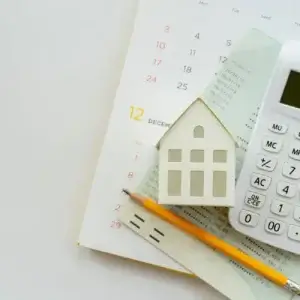Home / Home Loans / Loan-to-value ratio (LVR…

Key takeways
- Your loan-to-value ratio (LVR) is the size of your home loan compared against the value of the property you’re buying
- It’s a ratio used by lenders in Australia to demonstrate what percentage of the property value you’re borrowing in the form of a home loan
- Your LVR will typically be determined by the size of your saved deposit – that’s what will determine how much you need to borrow to buy your desired property
- You can improve your LVR by saving a larger deposit
Our LVR calculator
LVR Calculator
Your loan-to-value ratio (LVR) is a percentage that expresses how big your home loan is, relative to the value of your property. Fill in the fields below to calculate your LVR.
Loan-to-value ratio (LVR)
0%
Generally speaking, lenders require borrowers to have an LVR of 80% or less if they want to avoid paying lenders mortgage insurance (LMI). If your LVR is too high for your liking, you may be able to reduce it by taking out a smaller home loan or aiming to buy a lower-value property.
Expert tips for understanding your LVR
Understanding how LVR works is a crucial building brick for planning out your home loan, and with that in mind, our General Manager for Money, Stephen Zeller has some LVR tips for you:

Your profession matters
Even if you’re not a first home buyer, by working in a specific industry (e.g. medical, accounting, law), your LMI costs may be waived when borrowing over 80% (or even as high as 95%) of the property’s value. Make sure you check with one of our Home Loan Specialists to see if your industry is eligible for this waiver.
LMI can apply for refinancers
Keep in mind you can be charged LMI again if you refinance your loan from one lender to another, as it’s not a once-off fee for the life of the loan. In some circumstances, you may be in a better financial position in the long-term paying LMI again when refinancing a loan if the new LMI fee is minimal and the new lender’s rate is more competitive.
See if you can find a better deal
If you originally took out a loan with a lender and paid LMI and your loan is now under 80% of the value of the property, it may be worth comparing home loans to see if you can find a more competitive deal. Our Home Loan Specialists will be able to review your rate and see if it is worth your while to make the switch.
What is LVR and how does it work?
What does LVR mean?

LVR is a percentage or number used to express your home loan amount relative to the total value of the property it’s attached to. Note that your LVR is based on the size of your home loan, not your merits as a borrower or your borrowing power.
LVR comes into play primarily during the home loan application process, during which you ask lenders for a loan of a certain size to help purchase a property of a certain value (pending bank valuation of the property).
The lender can look at the size of the requested loan relative to the value of the property and use that ratio (among other factors and lending criteria) to help them decide whether you’re a low or high risk to lend money to.
How to work out LVR
To demonstrate how LVR is calculated, let’s imagine you want to take out a $400,000 home loan to buy a house valued at $500,000. The loan represents 80% of the property’s value, meaning this hypothetical home loan would have an LVR of 80%.
For this example, we’ve excluded upfront homebuying costs like legal fees, stamp duty and lenders mortgage insurance (LMI). However, these kinds of fees and costs can affect how much you might need to borrow and therefore your total homebuying costs, so we recommend keeping them in mind when assessing your own financial situation.
It’s worth noting that your LVR can be affected by factors beyond your control over the life of your loan – if the property market shifts, the change to your property’s value will affect your LVR. If property prices go up, your equity will increase and your LVR will decrease. Conversely, if the property market slumps and the value of your property decreases, your equity will decrease and your LVR will increase.
What is a good LVR?
While there’s typically no such thing as a ‘good’ or ‘bad’ LVR, you can safely assume that a lower LVR and a larger deposit will usually pose less risk to both you and the lender – some lenders will even have lower interest rates on offer for borrowers with low LVRs.
However, there are a few different thresholds to keep in mind when we’re talking LVR.
The first is 80%, which was traditionally the maximum LVR you can have before a lender may require you to also take out Lenders Mortgage Insurance (LMI). Paying LMI can add significantly to the balance of your home loan, as well as significantly drive up your regular repayments.
However, the introduction of the First Home Guarantee has changed this for eligible first home buyers who, with the help of the scheme, can now take out a home loan with an LVR of up to 95% without paying LMI.¹
If you’ve already bought a house and are looking to buy another, you may still want to aim for an LVR under 80%, as you’ll typically have to pay LMI otherwise.
LMI is designed to protect the lender if you’re unable to repay your loan (also known as defaulting), and the higher your LVR is, the higher risk you pose as a borrower. Although forgoing a larger deposit and paying this fee may help you get into the market quicker, it can also make your home loan noticeably more expensive. If you want to avoid LMI, you can always choose to hold off and save for a bigger deposit so you end up with an LVR of under 80%.
You and your LVR
How can I avoid LMI with a LVR above 80%?

If you have a high LVR (above 80%), you may be able to apply for a ‘guarantor’ loan. Typically, the way this would work is that a family member would become your guarantor and put up the equity they’ve built in their own home as additional security against your loan.
This could help you avoid paying LMI by ‘guaranteeing’ to the lender that someone will pay off the home loan if you can’t.²
However, the bank still needs to do their due diligence and make sure that your guarantor has sufficient equity in their own home (i.e. they’ve paid off enough of their own mortgage) and the financial means to take over your home loan if needed.
Keep in mind that a guarantor becomes wholly and solely responsible for your home loan repayments if you can’t pay, so you should carefully consider this option. A default on your part could cause difficulties for your guarantor(s).
However, this isn’t your only option. As mentioned above, the Australian Government has several schemes designed to help prospective homebuyers get on the property ladder without a 20% deposit.
The First Home Guarantee allows eligible first home buyers to take out a home loan with as little as a 5% deposit without attracting LMI, and the Family Home Guarantee helps eligible single parents take out a home loan with as little as a 2% deposit.³
Both schemes involve the government guaranteeing the borrower for the difference between their original deposit and a 20% deposit, helping them avoid LMI. Be sure to assess your eligibility for these schemes before applying.
Certain lenders may choose not to charge LMI on some loans with an LVR over 80% depending on your occupation and income, so compare your options and enquire about what’s on offer from different lenders before resigning yourself to paying LMI.
Should I refinance once my LVR changes?
If you entered your loan with an LVR greater than 80%, you may want to consider refinancing when you’ve repaid enough of the loan for its LVR to drop below 80%; this could potentially help you save money.
This is because a lender may charge a higher interest rate on home loans with higher LVRs. If your LVR has dropped, you may be able to refinance to a home loan with a more favourable interest rate. This, in turn, will generally reduce the size of your home loan repayments, and potentially reduce your loan term.
When refinancing, your lender or new lender may re-assess the value of the property to check its current property price, as the original purchase price or market value may no longer be accurate.
It’s important to note that if you refinance with an existing LVR of more than 80%, you’ll most likely be starting your LMI payments from scratch with your new lender, as LMI isn’t transferrable from one lender to another. If this is the case, you may decide that refinancing isn’t feasible for you right now.
Meet our home loans expert, Stephen Zeller
Stephen has more than 30 years of experience in the financial services industry and holds a Certificate IV in Finance and Mortgage Broking. He’s also a member of both the Australian and New Zealand Institute of Insurance and Finance (ANZIIF) and the Mortgage and Finance Association of Australia (MFAA).
Stephen leads our team of Mortgage Brokers, and reviews and contributes to Compare the Market’s banking-related content to ensure it’s as helpful and empowering as possible for our readers.
Want to know more about home loans?
1 National Housing Finance and Investment Corporation. First Home Guarantee. 2023.
2 Moneysmart.gov.au. Going guarantor on a loan. 2023.
3 National Housing Finance and Investment Corporation. Family Home Guarantee. 2023.


